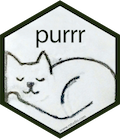Iteration and functionals
STAT 220
Why repeat ourselves?
It would be nice to iterate this process so that the same function/operation can be ran multiple times
For loops
What is a For loop?
- A for loop is a way to iterate through a series of items stored as a data object in R.
for loop components
the for() function is used to specify
- what object we’re drawing from and
- what object we are writing to
for(i in items)
^ ^
| |
| |___ object we are drawing from
|
|
obj. we write each item to
for loop components
The brackets {}
- Inside the brackets we house the code that is going to happen each iteration
for( i in items ){
|~~~~~~~~~~~~~~~~|
|~~~~~~~~~~~~~~~~|
|~~~~~~~~~~~~~~~~| code we need perform on each iteration.
|~~~~~~~~~~~~~~~~|
|~~~~~~~~~~~~~~~~|
}
for loops tinydata
- Let’s iterate calculation of column means:
Function for conditional evaluation
if x is numeric then standardize, else just return x
standardize <- function(x, ...){ # ... placeholder for optional args
if (is.numeric(x)){ # condition
(x - mean(x, ...))/sd(x, ...) # if TRUE, standardize
} else{ # else (FALSE)
x # return x unchanged
}
}
standardize(c(2,4,6,8, 10))[1] -1.2649111 -0.6324555 0.0000000 0.6324555 1.2649111[1] "2" "4" "6" "8" "10"[1] -1.1618950 -0.3872983 0.3872983 1.1618950 NAStandardizing tinydata
# allocate storage in a new data frame
scaled_tinydata <- tinydata %>% mutate(x = NA, y = NA, z = NA)
for (i in seq_along(tinydata)){
scaled_tinydata[, i] <- standardize(tinydata[[i]])
}
scaled_tinydata# A tibble: 3 × 4
case x y z
<chr> <dbl> <dbl> <dbl>
1 a -1 -0.398 0.873
2 b 0 -0.740 -1.09
3 c 1 1.14 0.218Group Activity 1

- Please clone the
ca15-yourusernamerepository from Github - Please do the problem 1 in the class activity for today
10:00
Functionals
Functional function will apply the same operation (function) to each element of a vector, matrix, data frame or list.

- base-R:
applyfamily of commands purrrpackage:mapfamily of commands
apply family of commands
R has a family of commands that apply a function to different parts of a vector, matrix or data frame
lapply(X, FUN): applies FUN to each element in the vector/list X
Example: lapply(tinydata, FUN = mean)
sapply(X, FUN): works like lapply, but returns a vector
Example: sapply(tinydata, FUN = mean)
purrr package
powerful package for iteration with the same functionality as apply commands, but more readable

map(.x, .f)maps the function.fto elements in the vector/list.x
lapply with tinydata
- a 3x4 data frame is summarized in a list of length 4.
- R sees
tinydataas a list whose elements are column vectors (variables) - the FUN is applied to each list element
- a list is returned
- length is the number of variables in the data frame
purrr::map
purrr::map_dbl
map_dbl is equivalent to sapply
purrr::map_df
Functionals: single function that mutates
standardize function gives us a list of standardized values
- a 3x4 data frame is mutated to a list of 4 vectors of length 3 each
purrr::map_df
In purrr, the map_df is equal to lapply + bind_cols:
- a 3x4 data frame is mutated to [standardized] 3x4 data frame
applying multiple functions
map_dfr: Getting Quantiles
map_dfc: Getting Quantiles
Group Activity 2

- Please do the remaining problems in the class activity.
- Submit to Gradescope on moodle when done!
10:00